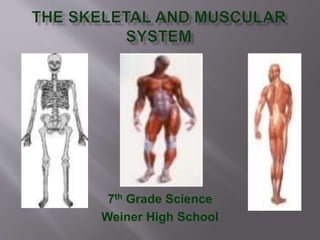
7th Grade Science "The skeletal and muscular system"
- 1. 7th Grade Science Weiner High School
- 2. Provides a framework for the body that helps protect the internal organs. Works with the muscles to enable the body to move. Has bone marrow that manufactures blood cells. Stores calcium & phosphorus needed for the body’s chemical processes.
- 3. Bones… Generally have 3 layers: 1. The Core, a spongy material containing bone marrow that makes new blood. 2. Compact bone, a hard dense layer that strengthens the skeleton. 3. The Periosteum, a thin layer that helps repair broken bones. Are not solid. They have microscopic canals that contain tiny blood vessels & nerve fibers connecting bone cells to the main blood & nerve supply. Joints… Are the points where two bones connect. Are primarily movable; although there are a few that are fixed, such as the adult skull that protects the brain. Are connected by ligaments, a flexible tissue made of collagen that holds the bones together. Are covered with cartilage that allows them to move smoothly. Consist of four basic types: 1. Ball-and-socket 2. Hinge 3. Pivot (Rotating) 4. Gliding
- 5. Is a mixture of bone and cartilage. Has ligaments that hold it together. Has about 206 bones. Is 70% nonliving tissue and about 30% living tissue. The nonliving part is made of minerals that make the bones hard. The living part is made of cells that maintain healthy bones and help heal bones when they break.
- 6. Works with the skeletal and nervous system to help move the body. Helps control body processes such as breathing, digestion, and blood flow. Holds the skeleton together and gives the body its build and general shape.
- 7. Are strong tissue made of long, thin cells called muscle fiber. Are arranged in layers over the skeleton and are attached to the bones or to other muscles by tendons. Number over 600 in the average person’s body. Work in pairs. When one muscle contracts, the other relaxes. Are either voluntary or involuntary: 1. Voluntary muscles control all forms of conscious movement. 2. Involuntary muscles control the movement of internal organs.
- 8. Are categorized as skeletal, smooth, or cardiac. 1. Skeletal muscles are voluntary muscles that help hold the bones of the skeleton together. 2. Smooth muscles are involuntary muscles that control the movement of internal organs such as the stomach and lungs 3. Cardiac muscles are involuntary muscles that form the walls of the heart.